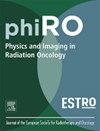呼吸导航仪引导的多层自由呼吸心脏T1在磁共振引导线性加速器上的成像
IF 3.4
Q2 ONCOLOGY
引用次数: 0
摘要
背景与目的磁共振引导直线加速器(MR-linac)图像引导心脏放射消融术正成为心律失常患者的一种无创治疗选择。这种治疗需要精确的目标识别。然而,由于在高能放射治疗期间使用钆基造影剂的问题,必须考虑非造影剂的替代品。原生T1定位是一种很有前途的心肌疤痕描绘技术,可以作为治疗目标的替代方法。此外,心律失常患者可能存在植入式心律转复除颤器(ICD),因此需要对金属相关伪影具有鲁棒性的方法。材料和方法我们在MR-linac上实现了心电图(ECG)触发的自由呼吸心脏T1映射方法,利用呼吸导航仪来解释呼吸运动。这项技术在运动幻影中得到验证,并在健康志愿者中进行了测试。我们还比较了不同读出方案的使用,以评估存在ICD时的性能。结果自由呼吸心脏T1测图方法与运动幻影的地面真实T1的一致性在5%以内。在健康志愿者中,自由呼吸和憋气方法之间的T1平均差异为- 3.5%,但T1量化受到呼吸导航器丢弃数据的影响。与平衡SSFP相比,干扰梯度回波读数对ICD引起的伪影的影响要小得多,但较低的信号对T1量化产生不利影响。结论在MR-linac上进行自由呼吸心脏T1定位是可行的。需要进一步优化以减少扫描时间并提高准确性。本文章由计算机程序翻译,如有差异,请以英文原文为准。
Respiratory navigator-guided multi-slice free-breathing cardiac T1 mapping on a magnetic resonance-guided linear accelerator
Background and Purpose
Image-guided cardiac radioablation on a magnetic resonance-guided linear accelerator (MR-linac) is emerging as a non-invasive treatment alternative for patients with cardiac arrhythmia. Precise target identification is required for such treatments. However, owing to concerns with the use of gadolinium-based contrast agents during treatment with high-energy radiation, non-contrast alternatives must be considered. Native T1 mapping is a promising technique to delineate myocardial scar which can serve as a surrogate for the treatment target. Further, the likely presence of an implantable cardioverter defibrillator (ICD) in arrhythmia patients necessitates approaches that are robust to metal-related artefacts.
Materials and Methods
We implemented an electrocardiogram (ECG)-triggered free-breathing cardiac T1 mapping approach on an MR-linac, making use of a respiratory navigator to account for respiratory motion. The technique was validated in a motion phantom and tested in healthy volunteers. We also compared the use of different readout schemes to evaluate performance in the presence of an ICD.
Results
The free-breathing cardiac T1 mapping approach agreed within 5% compared with ground truth T1 in a motion phantom. In healthy volunteers, an average difference in T1 of −3.5% was seen between the free-breathing and breath-hold approaches, but T1 quantification was impacted by data discarded by the respiratory navigator. Compared to balanced SSFP, the spoiled gradient echo readout was much less susceptible to artefacts caused by an ICD, but the lower signal adversely affected T1 quantification.
Conclusions
Free-breathing cardiac T1 mapping is feasible on an MR-linac. Further optimisation is required to reduce scan times and improve accuracy.
求助全文
通过发布文献求助,成功后即可免费获取论文全文。
去求助
来源期刊

Physics and Imaging in Radiation Oncology
Physics and Astronomy-Radiation
CiteScore
5.30
自引率
18.90%
发文量
93
审稿时长
6 weeks
 求助内容:
求助内容: 应助结果提醒方式:
应助结果提醒方式:


